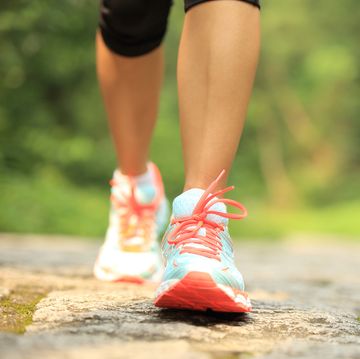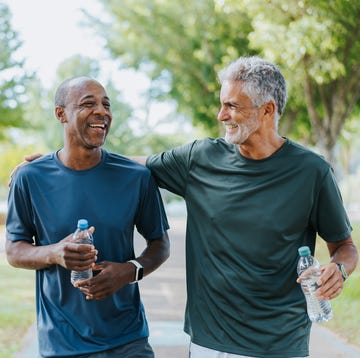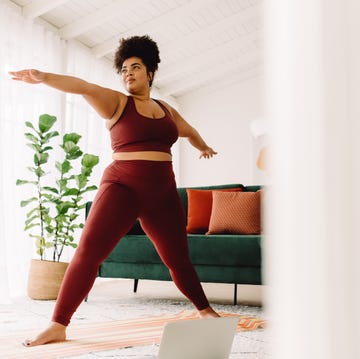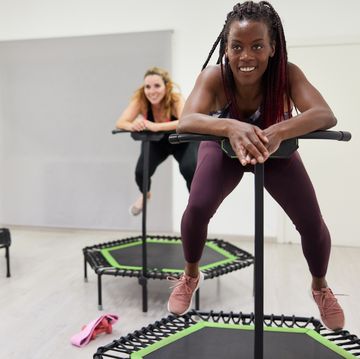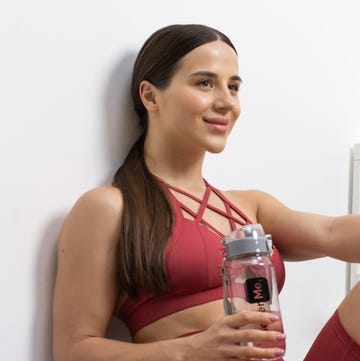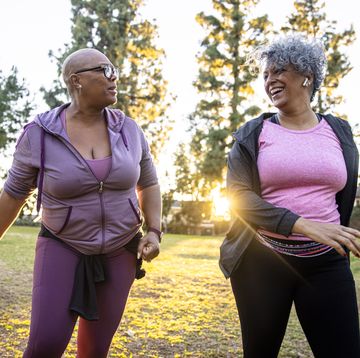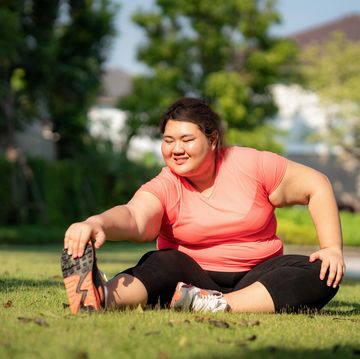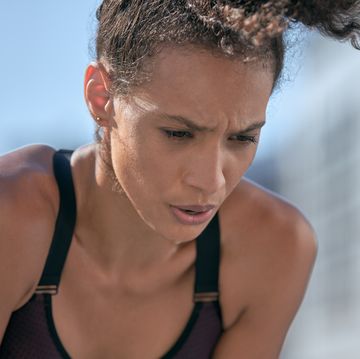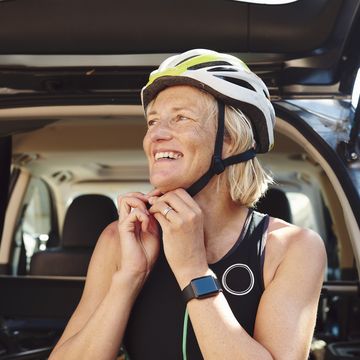Setting — and completing — a fitness goal can be amazing for both your mind and body. However, we often set unrealistic goals that are difficult to sustain for a long period of time. If your overall goal is to move more or increase the intensity of your current exercise regimen, setting specific and achievable targets can be the secret to lasting change.
The best part about fitness goals is that they don’t have to be (and shouldn’t be!) big things that require you to overhaul your routine. “The research is very clear that small improvements in physical activity can have large impacts on our physical and mental health,” says Tommy Wood, BM, BCh, PhD, an assistant professor of pediatrics and neuroscience at the University of Washington and the co-host of Better Brain Fitness Podcast. “Any increase in physical activity above and beyond what you’re doing now will be beneficial — even adding 1,000 steps to your day or joining a fitness class once a week.”
Editor's Note: You should clear any long-term changes to your fitness routine with your primary healthcare provider beforehand. Weight loss, health and body image are complex subjects — before deciding to switch up your exercise and fitness levels, we invite you to gain a broader perspective with our exploration into the hazards of diet culture.
Whether you choose to focus on a particular fitness skill or exercising more in general, the most important thing is to think about your values. “For example, if the initial goal is to ‘lose 10 pounds,’ drill down a bit deeper and ask yourself why that is an important goal for you,” says Jacque Crockford, DHSc, an ACE Certified Personal Trainer. “Very generally speaking, weight loss goals usually have nothing to do with actually changing the weight on the scale. Doing this value assessment is essential as it will help to solidify what is important on an intrinsic level, versus chasing an external goal, which has been shown to lead to long-term behavior change, versus short-term solutions.”
Not sure where to start? Consider the expert-approved fitness goals below and remember that whatever goals you set are unique to you and need to be suited to your lifestyle. It’s also smart to consult your healthcare provider before starting any new fitness regimen.
How to set a S.M.A.R.T. fitness goal
"Setting smart fitness goals are so important to keep you focused and accountable," says Kirsten Ferguson, Peloton Tread Instructor. Try to make each goal (S)pecific, (M)easurable, (A)chievable, (R)ealistic and (T)imely. "Far too often, people set fitness goals without a plan, with no time limit and they aren’t realistic to achieve and when they don’t happen right away, unfortunately people quit." She adds that with every goal you set, it's important that they are not only realistic but also small and manageable. Choose a goal that is meaningful to you and create a timeline to make it happen.
Realistic fitness goals
1.Walk more
“Often, we think that exercise has to be ‘hard’ for it to be beneficial, but a huge amount of research shows that walking is associated with improved health across the board,” says Wood. “ It requires no equipment and can have impressive health benefits.” Yes, you can walk a dog or park your car farther away from places you need to go, but Wood also likes the three strategies below for upping your step game if you have a sedentary job.
How to achieve it:
2. Do an elevated plank challenge
Planks are excellent moves to improve your core strength, but they’re not for everyone. “Traditional plank exercises can be really hard on your core and pelvic floor, as well as your wrists. This is especially true if you have diastasis recti," says Ashley Nowe, a certified pre- and postnatal corrective exercise specialist and the founder of Get Mom Strong. Diastasis rectis is a thinning of the connective tissue between your abdominals which tends to occur during pregnancy and causes your left and right abdominals to separate. “A better option for many is to add a little elevation to your plank. This makes it easier to engage your deep core muscles, and better protect your pelvic floor,” explains Nowe.
How to achieve it:
3. Take a class
“One of the best ways to support long-term physical health as well as brain health is to learn a new skill, especially if it’s paired with some movement,” says Wood. “Exercise classes are a perfect way to do this.” Not only do classes help you learn something new, they allow you to be part of a community of people with a similar interest. By booking a class you’re also committing yourself and blocking off time on your calendar to work out so it’s harder to back out. “The options are essentially limitless, and any class you think you might enjoy is the one you should try,” Wood adds.
Fitness classes to consider:
4. Complete a race
By signing up for a race like a 5K or triathlon, you’re committing to do something fitness-related within a specific time frame with other people so you may be more likely to achieve it. “With performance-related goals, it’s all about the process, taking things one day at a time,” says Crockford. “With an end goal in mind, with a date, it can make the step-by-step process feel more doable.” Plus, most races require you to pay money to register so you won’t want to lose out on that cash by skipping the race.
How to achieve it:
5. Do a "squat ladder"
“Squats are great for mobility, posture and, well, they help the shape of our glutes, too,” says Nowe. A fitness “ladder” is taking one particular exercise move and adding onto it every day. In this case, you would start with a number like 10 squats on the first day and then add 10 more every day for a week so by the end you’re completing 70 squats. Hello, glutes!
How to achieve it:
6. Commit to three 10-minute daily movement breaks
Wood refers to these little breaks as “movement snacks.” “Recent research shows that even very brief periods of movement can add up to having a big impact on health,” he says. “Better yet, you don’t need to worry about taking the time to prepare or change your clothes — they can be spontaneous! A movement snack can be literally anything — a brief walk, taking a couple of flights of stairs or even doing a few squats, push-ups or jumping jacks next to your desk.” Not only will these little bouts of exercise benefit your physical health, Nowe points out that they’ll give you a boost of feel-good endorphins to lift your mood.
How to achieve it:
7. Incorporate weights into workouts
Adding weight to exercise moves can increase your calorie burn and build muscles so your workouts are more efficient. That said, if you’ve never used weights before, it’s best to start using them with a fitness professional, Crockford says.
How to achieve it:
8. Improve your bridge hold
“Bridges are one of the most beneficial exercises for women postpartum through menopause,” says Nowe. “ In fact, bridges are 56% more effective at pelvic floor activation than a kegel! Bridges work to build strong glutes, activate your corset abdominal muscles (transverse abdominis) and strengthen your pelvic floor in a gentle way.”
How to achieve it:
9. Stretch for 10 minutes every day
Flexibility varies widely from person to person, but inactivity or lack of stretching can minimize the body's range of motion. When you have limited range of motion, you may have trouble performing everyday tasks, let alone fitness moves. Lengthening and stretching muscles can also help prevent injuries and energize the body.
How to achieve it:
10. Prioritize recovery
"One example that doesn't get enough celebration is the fitness goal of rest and recovery," says Chelsea Jackson Roberts, Ph.D., Peloton Yoga & Meditation Instructor. "For every day or hour that you work out, try and commit to that equal amount of rest either the same day or the next." If you're starting up a new exercise regimen or performing exercise that you haven't done in a while, proper recovery is especially important because you may experience delayed onset muscle soreness. We know that exercise has a slew of health benefits, and in order to stay consistent with a workout regimen, proper recovery is essential.
How to achieve it:
How to stay motivated to achieve fitness goals
- Mark time in your calendar for exercise: "Set a schedule just like you set a meeting on your work calendar or your kids after school schedule,” suggests Ferguson. “Make the times realistic when you know you will have the least amount of distractions.” When the time comes, try your best not to back out of a planned workout. "Just as we schedule lunch dates and place responsibilities for work in our daily calendars, it is just as important to place those commitments towards our fitness goals there too," Roberts adds.
- Recruit a workout partner: A friend or family member can help hold you accountable and make working out more enjoyable. "I think there is something so powerful in knowing that you aren’t going at your goals alone," says Ferguson. "On the days that you really don’t feel like doing it, your friend will motivate you to show up and show out!" The best part? You don’t have to see your cheerleader in person. "Even if you can't be in the same physical place as the individual, create opportunities to check in or even Facetime during a workout," Roberts says.
- Find a fitness goal quote you love: An inspirational quote can be an amazing motivator. Write it out and place it somewhere visible, or make it your phone or desktop background so you see it every day.
- Keep a journal of your fitness journey: "I am a big proponent of reflecting on my experiences through journal writing," Roberts shares. "Practice recording your workouts either written or even voice memos. For me, this is a practice that helps me see and hear my accomplishments over time."
- Celebrate small wins: When it comes to staying motivated, it's important to focus on improvements you make along the way. "I am a big stickler for progress over perfection," says Ferguson. "Enjoy every little, small victory in the process towards greatness."
Kaitlyn Phoenix is a deputy editor in the Hearst Health Newsroom, where she reports, writes and edits research-backed health content for Good Housekeeping, Prevention and Woman's Day. She has more than 10 years of experience talking to top medical professionals and poring over studies to figure out the science of how our bodies work. Beyond that, Kaitlyn turns what she learns into engaging and easy-to-read stories about medical conditions, nutrition, exercise, sleep and mental health. She also holds a B.S. in magazine journalism from Syracuse University.
Stefani (she/her) is a registered dietitian, a NASM-certified personal trainer and the director of the Good Housekeeping Institute Nutrition Lab, where she handles all nutrition-related content, testing and evaluation. She holds a bachelor’s degree in nutritional sciences from Pennsylvania State University and a master’s degree in clinical nutrition from NYU. She is also Good Housekeeping’s on-staff fitness and exercise expert. Stefani is dedicated to providing readers with evidence-based content to encourage informed food choices and healthy living. She is an avid CrossFitter and a passionate home cook who loves spending time with her big fit Greek family.



